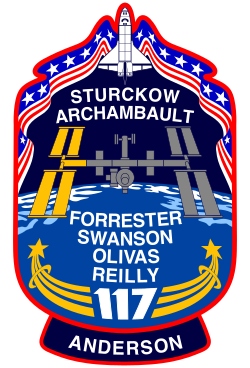Steven Swanson
| Steven Ray Swanson | |
|---|---|
 | |
| Astronaut NASA | |
| Státní příslušnost | Spojené státy americké |
| Datum narození | 3. prosince 1960 (62 let) |
| Místo narození | Syracuse, New York, USA |
| Čas ve vesmíru | 195 dní, 20 hodin 48 minut |
| Kosmonaut od | 4. června 1998 |
| Mise | STS-117, STS-119, Expedice 39/40 (Sojuz TMA-12M/ISS) |
| Znaky misí | |
| Některá data mohou pocházet z datové položky. | |
Steven Ray "Swanny" Swanson (* 3. prosince 1960, Syracuse, New York, USA) je od roku 1998 astronaut NASA.
Životní dráha
Lety do vesmíru
- STS-117, Atlantis (8. června 2007 – 22. června 2007)
- STS-119, Discovery (16. března 2009 – 28. března 2009)
V létě 2011 byl zařazen do záložní posádky Expedice 37/38 na Mezinárodní vesmírnou stanici (ISS) a hlavní posádky Expedice 39/38.[1] K ISS odstartoval 25. března 2014 ve funkci palubního inženýra lodi Sojuz TMA-12M, společně s Alexandrem Skvorcovem a Olegem Artěmjevem.[2] Kvůli problémům s orientačním systémem lodi se plánovaný šestihodinový let ke stanici protáhl na dva dny.[3] Na ISS pracoval jako palubní inženýr devětatřicáté a (od května 2014) velitel čtyřicáté expedice. Během letu jednou vystoupil do vesmíru.[4] Dne 11. září 2014 Swanson, Artěmjev a Skvorcov v pořádku přistáli v Sojuzu TMA-12M na Zemi.[2]
Reference
- ↑ IVANOV, Ivan, a kol. Космическая энциклопедия ASTROnote [online]. Moskva: rev. 2009-09-30 [cit. 2009-10-05]. Kapitola Александр Александрович Скворцов, мл.. Dostupné online. (rusky)
- ↑ a b HOLUB, Aleš. MEK. Malá encyklopedie kosmonautiky [online]. Rev. 2014-9-11 [cit. 2014-09-24]. Kapitola Sojuz TMA-12M. [Dále jen Holub]. Dostupné online.
- ↑ ČTK. Sojuz se s dvoudenním zpožděním spojil s ISS. Aktuálně.cz [online]. Economia, 2014-3-28 [cit. 2014-3-28]. Dostupné online.
- ↑ Holub. Swanson, S.R. [online]. Rev. 2014-9-11 [cit. 2014-09-24]. Dostupné online.
Externí odkazy
 Obrázky, zvuky či videa k tématu Steven Swanson na Wikimedia Commons
Obrázky, zvuky či videa k tématu Steven Swanson na Wikimedia Commons - http://www.lib.cas.cz/space.40/ASTRON/USA/SWAN-SR.HTM
- http://mek.kosmo.cz/bio/usa/00455.htm
Média použitá na této stránce
ISS Expedition 39 Patch
Increment 39 of the International Space Station Program marks the 15th year of operation since the start of the space laboratory assembly. Today, the U.S., Russia, Japan, Canada and the European Space Agency are partnering in the operation of the largest ever orbital outpost managed by humankind. The names of the six crew members are depicted in their native languages. For Expedition 39, the Soyuz spacecraft serves as transport vehicle for the crew members to and from the station. During this expedition, the ISS will serve as a platform for scientific research, Earth and astronomical observation, education, as well as a stage for the development of new technologies used for the exploration beyond low Earth orbit. The star above the complex signifies human space exploration towards new frontiers. The crew members added these words: "The crew of Expedition 39 is proud to serve the international community in furthering our scientific knowledge and in expanding human presence in space."
The Expedition 40 patch depicts the past, present, and future of human space exploration. The crew wrote the description that follows: The reliable and proven Soyuz, our ride to the International Space Station (ISS), is a part of the past, present, and future. The ISS is the culmination of an enormous effort by many countries partnering to produce a first-class orbiting laboratory, and its image represents the current state of space exploration. The ISS is immensely significant to us as our home away from home and our oasis in the sky. The commercial cargo vehicle is also part of the current human space exploration and is a link to the future. A blend of legacy and future technologies is being used to create the next spacecrafts which will carry humans from our planet to destinations beyond. The sun on Earth's horizon represents the new achievements and technologies that will come about due to our continued effort in space exploration.
The STS-117 crew patch symbolizes the continued construction of the International Space Station (ISS) and our ongoing human presence in space. The ISS is shown orbiting high above the Earth. Gold is used to highlight the portion of the ISS that will be installed by the STS-117 crew. It consists of the second starboard truss section, S3/S4, and a set of solar arrays. The names of the STS-117 crew are located above and below the orbiting outpost. The two gold astronaut office symbols, emanating from the '117' at the bottom of the patch represent the concerted efforts of the shuttle and station programs toward the completion of the station. The orbiter and unfurled banner of red, white and blue represent our Nation's renewed patriotism as we continue to explore the universe.
The shape of the STS-119/15A patch comes from the shape of a solar array viewed at an angle. The International Space Station (ISS), which is the destination of the mission, is placed accordingly in the center of the patch just below the gold astronaut symbol. The gold solar array of the ISS highlights the main cargo and task of STS-119/15A -- the installation of the S6 truss segment and deployment of S6's solar arrays, the last to be delivered to the ISS. The surnames of the crew members are denoted on the outer band of the patch. The 17 white stars on the patch represent, in the crew's words, "the enormous sacrifice the crews of Apollo 1, Challenger, and Columbia have given to our space program." The U.S. flag flowing into the space shuttle signifies the support the people of the United States have given our space program over the years, along with pride the U.S. astronauts have in representing the United States on this mission.




